Solubility, Permeability, Anti-Inflammatory Action and In Vivo Pharmacokinetic Properties of Several Mechanochemically Obtained Pharmaceutical Solid Dispersions of Nimesulide
Abstract
1. Introduction
2. Results and Discussion
2.1. Physical Characterization Studies of NIM SD
2.2. Characteristics of NIM SD in Solutions
2.2.1. Intrinsic Solubility of NIM from Mechanically Treated Samples
2.2.2. 1H-NMR Spectroscopy of the Aqueous Solutions of NIM and Its Solid Dispersions
Self-Association of NIM in Aqueous Solutions
Interaction of Nimesulide with Na2GA in Aqueous Solutions
Inclusion Complex Formation of NIM with HP-β-CD in Water Solution
Inclusion Complex Formation of NIM from SD with Polysaccharide Arabinogalactan in Water Solution
Chelate Complex Formation of NIM with MgCO3 in Water Solution
2.2.3. In Vitro Permeation Study
2.3. In Vivo Tests
2.3.1. Anti-Inflammatory Study of NIM and Its Compositions
2.3.2. Pharmacokinetics of NIM and Its Compositions
3. Materials and Methods
3.1. Materials
3.2. Preparation of NIM Composition with Excipients
3.3. HPLC Analyses
3.4. Content Test for NIM and Its Compositions
3.5. Intrinsic Solubility Study for NIM and Its Complexes
3.6. Powder X-ray Diffraction (XRD)
3.7. Differential Scanning Calorimetry (DSC)
3.8. Scanning Electron Microscopy (SEM)
3.9. Gel Permeation Chromatography (GPC)
3.10. 1H-NMR Spectroscopy
3.11. In Vitro Parallel Artificial Membrane Permeability Assay (PAMPA)
3.12. Optical Absorption Studies the NIM-Mg2+ Chelate Complex
3.13. In Vivo Study
3.13.1. Animals
3.13.2. Pharmacokinetic Study
3.13.3. Anti-Inflammatory Study
3.13.4. Statistical Analysis
4. Conclusions
Author Contributions
Funding
Institutional Review Board Statement
Informed Consent Statement
Data Availability Statement
Conflicts of Interest
Sample Availability
References
- Singla, A.K.; Chawla, M.; Singh, A. Nimesulide: Some pharmaceutical and pharmacological aspects. J. Pharm. Pharmacol. 2000, 52, 467–486. [Google Scholar] [CrossRef]
- Rainsford, K.D. Nimesulide—Actions and Uses; Birkhäuser Basel: Basel, Switzerland, 2005. [Google Scholar]
- Kwon, J.; Kim, S.; Yoo, H.; Lee, E. Nimesulide-induced hepatotoxicity: A systematic review and meta-analysis. PLoS ONE 2019, 14, e0209264. [Google Scholar] [CrossRef] [PubMed]
- Rainsford, K.D. Nimesulide—A multifactorial approach to inflammation and pain: Scientific and clinical consensus. Curr. Med. Res. Opin. 2006, 22, 1161–1170. [Google Scholar] [CrossRef] [PubMed]
- Reddy, B.B.K.; Karunakar, A. Biopharmaceutics classification system: A regulatory approach. Dissolution Technol. 2011, 18, 31–37. [Google Scholar] [CrossRef]
- Tubi, B.; Uzunovic, A.; Pilipovic, S.; Gagic, Z. Dissolution profile of nimesulide from pharmaceutical preparations for oral use. Acta Chim. Slov. 2016, 63, 193–199. [Google Scholar]
- Kawabata, Y.; Wada, K.; Nakatani, M.; Yamada, S.; Onoue, S. Formulation design for poorly water-soluble drugs based on biopharmaceutics classification system: Basic approaches and practical applications. Int. J. Pharm. 2011, 420, 1–10. [Google Scholar] [CrossRef]
- Dushkin, A.V.; Tolstikova, T.G.; Khvostov, M.V.; Tolstikov, G.A. Complexes of polysaccharides and glycyrrhizin acid with drugs molecules—Mechanochemical synthesis and pharmacological activity. In The Complex World of Polysaccharides; Karunaratne, D.N., Ed.; IntechOpen: Rijeka, Croatia, 2012; pp. 573–602. [Google Scholar]
- Chistyachenko, Y.S.; Dushkin, A.V.; Polyakov, N.E.; Khvostov, M.V.; Tolstikova, T.G.; Tolstikov, G.A.; Lyakhov, N.Z. Polysaccharide arabinogalactan from larch Larix sibirica as carrier for molecules of salicylic and acetylsalicylic acid: Preparation, physicochemical and pharmacological study. Drug Deliv. 2015, 22, 400–407. [Google Scholar] [CrossRef]
- Chistyachenko, Y.S.; Meteleva, E.S.; Pakharukova, M.Y.; Katokhin, A.V.; Khvostov, M.V.; Varlamova, A.I.; Glamazdin, I.I.; Khalikov, S.S.; Polyakov, N.E.; Arkhipov, I.A.; et al. Physico chemical and pharmacological study of the newly synthesized complex of albendazole and polysaccharide arabinogalactan from larch wood. Curr. Drug Deliv. 2015, 12, 477–490. [Google Scholar] [CrossRef]
- Khvostov, M.V.; Tolstikova, T.G.; Borisov, S.A.; Dushkin, A.V. Application of natural polysaccharides in pharmaceutics. Russ. J. Bioorg. Chem. 2019, 45, 438–450. [Google Scholar] [CrossRef]
- Meteleva, E.S.; Chistyachenko, Y.S.; Suntsova, L.P.; Khvostov, M.V.; Polyakov, N.E.; Selyutina, O.Y.; Tolstikova, T.G.; Frolova, T.S.; Mordvinov, V.A.; Dushkin, A.V.; et al. Disodium salt of glycyrrhizic acid—A novel supramolecular delivery system for anthelmintic drug praziquantel. J. Drug Deliv. Sci. Technol. 2019, 50, 66–77. [Google Scholar] [CrossRef]
- Li, J.Y.; Cao, H.Y.; Liu, P.; Cheng, G.H.; Sun, M.Y. Glycyrrhizic acid in the treatment of liver diseases: Literature review. Biomed. Res. Int. 2014, 2014, 872139. [Google Scholar] [CrossRef]
- Sun, J.; Wen, X.; Liu, J.; Kan, J.; Qian, C.; Wu, C.; Jin, C. Protective effect of an arabinogalactan from black soybean against carbon tetrachloride-induced acute liver injury in mice. Int. J. Biol. Macromol. 2018, 117, 659–664. [Google Scholar] [CrossRef]
- Alexanian, C.; Papademou, H.; Vertzoni, M.; Archontaki, H.; Valsami, G. Effect of pH and water-soluble polymers on the aqueous solubility of nimesulide in the absence and presence of β-cyclodextrin derivatives. J. Pharm. Pharmacol. 2008, 60, 1433–1439. [Google Scholar] [CrossRef] [PubMed]
- Chowdary, K.P.R.; Rao, K.S.P.; Shaik, R. Enhancement of solubility and dissolution rate of nimesulide by cyclodextrins, poloxamer and PVP. Int. J. Chem. Sci. 2011, 9, 637–646. [Google Scholar]
- Saumya, D.; Dharmajit, P.; Prasad, S.N. Dissolution enhancement of nimesulide using HP-ß-CD. J. Pharm. Res. 2012, 5, 508–510. [Google Scholar]
- Murugan, E.; Geetha Rani, D.P.; Yogaraj, V. Drug delivery investigations of quaternised poly(propylene imine) dendrimer using nimesulide as a model drug. Colloid. Surface. B. 2014, 114, 121–129. [Google Scholar] [CrossRef]
- Semalty, A.; Tanwar, Y.S. Nimesulide-phosphatidylcholine complex for improvement of solubility and dissolution. Am. J. Drug Discov. Dev. 2013, 3, 225–234. [Google Scholar] [CrossRef]
- Dantu, A.S.; Durai, R.; Vedha Hari, B.N. Effect of impact and attrition milling on nimesulide for solubility enhancement. Int. J. Appl. Pharm. 2013, 5, 1–7. [Google Scholar]
- Neha, A.; Singh, I.; Sharma, M.; Garg, T. An approach for improvement of the water solubility of nimesulide in solid dispersion with PEG 4000. IOSR J. Pharm. 2012, 2, 153–154. [Google Scholar]
- Akhtar, S.; Khan, M.A.; Shahid, K.; Akhtar, H. Metal complexes of nimesulide; synthesis, characterization and in-vitro biological screening. Int. J. Res. Pharm. Sci. 2014, 4, 31–35. [Google Scholar]
- Auda, S.H. Nimesulide/methyl β-cyclodextrin inclusion complexes: Physicochemical characterization, solubility, dissolution, and biological studies. Drug Dev. Res. 2014, 75, 68–75. [Google Scholar] [CrossRef]
- Dushkin, A.V. Potential of mechanochemical technology in organic synthesis and synthesis of new materials. Chem. Sustain. Dev. 2004, 12, 251–273. [Google Scholar]
- Dushkin, A.V. Mechanochemical synthesis of organic compounds and rapidly soluble materials. In High Energy Ball Milling. Mechanochemical Processing of Nanopowders; Sopicka-Lizer, M., Ed.; Woodhead Publishing Limited: Oxford, UK, 2010; pp. 249–273. [Google Scholar]
- Wang, G.W. Mechanochemical organic synthesis. Chem. Soc. Rev. 2013, 42, 7668–7700. [Google Scholar] [CrossRef]
- Yu, J.B.; Zhang, Y.; Jiang, Z.J.; Su, W.K. Mechanically induced Fe(III) catalysis at room temperature: Solvent-free cross-dehydrogenative coupling of 3-benzylic Indoles with methylenes/indoles. J. Org. Chem. 2016, 81, 11514–11520. [Google Scholar] [CrossRef]
- Braga, D.; Maini, L.; Grepioni, F. Mechanochemical preparation of CO-crystals. Chem. Soc. Rev. 2013, 42, 7638–7648. [Google Scholar] [CrossRef]
- Descamps, M.; Willart, J.F. Perspectives on the amorphisation/milling relationship in pharmaceutical materials. Adv. Drug Deliv. Rev. 2016, 100, 51–66. [Google Scholar] [CrossRef]
- Loftsson, T.; Brewster, M.E. Pharmaceutical applications of cyclodextrins: Basic science and product development. J. Pharm. Pharmacol. 2010, 62, 1607–1621. [Google Scholar] [CrossRef] [PubMed]
- Odonmazig, P.; Ebringerova, A.; Machova, E.; Alfoldi, J. Structural and molecular properties of the arabinogalactan isolated from Mongolian larchwood (Larix dahurica L.). Carbohydr. Res. 1994, 252, 317–324. [Google Scholar] [CrossRef]
- Trofimova, N.N.; Medvedeva, E.N.; Ivanova, N.V.; Malkov, Y.A.; Babkin, V.A. Polysaccharides from larch biomass. In The complex world of polysaccharides; Karunaratne, D.N., Ed.; InTech: Rijeka, Croatia, 2012; pp. 153–194. [Google Scholar]
- Dushkin, A.V.; Meteleva, E.S.; Tolstikova, T.G.; Tolstikov, G.A.; Polyakov, N.E.; Neverova, N.A.; Medvedeva, E.N.; Babkin, V.A. Mechanochemical preparation and pharmacological activities of water-soluble intermolecular complexes of arabinogalactan with medicinal agents. Russ. Chem. Bull. 2008, 57, 1299–1307. [Google Scholar] [CrossRef]
- Mikhailenko, M.A.; Shakhtshneider, T.P.; Eltsov, I.V.; Kozlov, A.S.; Kuznetsova, S.A.; Karacharov, A.A.; Boldyrev, V.V. Supramolecular architecture of botulin diacetate complexes with arabinogalactan from Larix sibirica. Carbohydr. Polym. 2015, 138, 1–7. [Google Scholar] [CrossRef]
- Du, L.; Alexander, V.; Dushkin, A.V.; Chistyachenko, Y.S.; Polyakov, N.E.; Su, W. Investigation the inclusion complexes of valsartan with polysaccharide arabinogalactan from larch Larix sibirica and (2-hydroxypropyl)-β-cyclodextrin: Preparation, characterization and physicochemical properties. J. Incl. Phenom. Macrocycl. Chem. 2016, 85, 93–104. [Google Scholar] [CrossRef]
- Khvostov, M.V.; Borisov, S.A.; Tolstikova, T.G.; Dushkin, A.V.; Tsyrenova, B.D.; Chistyachenko, Y.S.; Polyakov, N.E.; Dultseva, G.G.; Onischuk, A.A.; An’kov, S.V. Supramolecular complex of ibuprofen with larch polysaccharide arabinogalactan: Studies on bioavailability and pharmacokinetics. Eur. J. Drug Metab. Pharmacokinet. 2017, 42, 431–440. [Google Scholar] [CrossRef]
- Su, X.; Wu, L.; Hu, M.; Dong, W.; Xu, M.; Zhang, P. Glycyrrhizic acid: A promising carrier material for anticancer therapy. Biomed. Pharmacother. 2017, 95, 670–678. [Google Scholar] [CrossRef]
- Selyutina, O.Y.; Polyakov, N.E. Glycyrrhizic acid as a multifunctional drug carrier - From physicochemical properties to biomedical applications: A modern insight on the ancient drug. Int. J. Pharm. 2019, 559, 271–279. [Google Scholar] [CrossRef] [PubMed]
- Dushkin, A.V.; Meteleva, E.S.; Tolstikova, T.G.; Khvostov, M.V.; Dolgikh, M.P.; Tolstikov, G.A. Complexing of pharmacons with glycyrrhizic acid as a route to the development of the preparations with enhanced efficiency. Chem. Sustain. Dev. 2010, 4, 437–444. [Google Scholar]
- Selyutina, O.Y.; Polyakov, N.E.; Korneev, D.V.; Zaitsev, B.N. Infuence of glycyrrhizin on permeability and elasticity of cell membrane: Perspectives for drugs delivery. Drug Deliv. 2016, 23, 848–855. [Google Scholar] [CrossRef]
- Selyutina, O.Y.; Apanasenko, I.E.; Kim, A.V.; Shelepova, E.A.; Khalikov, S.S.; Polyakov, N.E. Spectroscopic and molecular dynamics characterization of glycyrrhizin membrane-modifying activity. Colloids Surf. B Biointerfaces 2016, 147, 459–466. [Google Scholar] [CrossRef] [PubMed]
- Kong, R.; Zhu, X.; Meteleva, E.S.; Polyakov, N.E.; Khvostov, M.V.; Baev, D.S.; Tolstikova, T.G.; Dushkin, A.V.; Su, W. Atorvastatin calcium inclusion complexation with polysaccharide arabinogalactan and saponin disodium glycyrrhizate for increasing of solubility and bioavailability. Drug Deliv. Transl. Res. 2018, 8, 1200–1213. [Google Scholar] [CrossRef]
- Zhang, Q.; Polyakov, N.E.; Chistyachenko, Y.S.; Khvostov, M.V.; Frolova, T.S.; Tolstikova, T.G.; Dushkin, A.V.; Su, W. Preparation of curcumin self-micelle solid dispersion with enhanced bioavailability and cytotoxic activity by mechanochemistry. Drug Deliv. 2018, 25, 198–209. [Google Scholar] [CrossRef]
- Kim, A.V.; Shelepova, E.A.; Selyutina, O.Y.; Meteleva, E.S.; Dushkin, A.V.; Medvedev, N.N.; Polyakov, N.E. Glycyrrhizin assisted transport of antihelminthic drug praziquantel through lipid membrane: Experiment and MD simulation. Mol. Pharm. 2019, 16, 3188–3198. [Google Scholar] [CrossRef]
- Glazachev, Y.I.; Schlotgauer, A.A.; Timoshnikov, V.A.; Kononova, P.A.; Selyutina, O.Y.; Shelepova, E.A.; Zelikman, M.V.; Khvostov, M.V.; Polyakov, N.E. Effect of glycyrrhizic acid and arabinogalactan on the membrane potential of rat thymocytes studied by potential-sensitive fluorescent probe. J. Membr. Biol. 2020, 253, 343–356. [Google Scholar] [CrossRef]
- Selyutina, O.Y.; Shelepova, E.A.; Paramonova, E.D.; Kichigina, L.A.; Khalikov, S.S.; Polyakov, N.E. Glycyrrhizin-induced changes in phospholipid dynamics studied by 1H NMR and MD simulation. Arch. Biochem. Biophys. 2020, 686, 108368. [Google Scholar] [CrossRef] [PubMed]
- Singh, S.; Sharda, N.; Mahajan, L. Spectrophotometric determination of pKa of nimesulide. Int. J. Pharm. 1999, 176, 261–264. [Google Scholar] [CrossRef]
- Apanasenko, I.E.; Selyutina, O.Y.; Polyakov, N.E.; Suntsova, L.P.; Meteleva, E.S.; Dushkin, A.V.; Vachali, P.; Bernstein, P.S. Solubilization and stabilization of macular carotenoids by water soluble oligosaccharides and polysaccharides. Arch. Biochem. Biophys. 2015, 572, 58–65. [Google Scholar] [CrossRef] [PubMed]
- Selyutina, O.Y.; Apanasenko, I.E.; Khalikov, S.S.; Polyakov, N.E. Natural poly- and oligosaccharides as novel delivery systems for plant protection compounds. J. Agric. Food Chem. 2017, 65, 6582–6587. [Google Scholar] [CrossRef]
- Meteleva, E.S.; Evseenko, V.I.; Teplyakova, O.I.; Khalikov, S.S.; Polyakov, N.E.; Apanasenko, I.E.; Dushkin, A.V.; Vlasenko, N.G. Nanopesticides on the basis of the supramolecular complexes of tebuconazole for the treatment of seeds of cereals. Chem. Sustain. Dev. 2018, 3, 279–294. [Google Scholar]
- Selyutina, O.Y.; Khalikov, S.S.; Polyakov, N.E. Arabinogalactan and glycyrrhizin based nanopesticides as novel delivery systems for plant protection. Environ. Sci. Pollut. Res. 2020, 27, 5864–5872. [Google Scholar] [CrossRef]
- Zhang, Q.; Suntsova, L.; Chistyachenko, Y.S.; Evseenko, V.; Khvostov, M.V.; Polyakov, N.E.; Dushkin, A.V.; Su, W. Preparation, physicochemical and pharmacological study of curcumin solid dispersion with an arabinogalactan complexation agent. Int. J. Biol. Macromol. 2019, 128, 158–166. [Google Scholar] [CrossRef]
- Kong, R.; Zhu, X.; Meteleva, E.S.; Chistyachenko, Y.S.; Suntsova, L.P.; Polyakov, N.E.; Khvostov, M.V.; Baev, D.S.; Tolstikova, T.G.; Yu, J.; et al. Enhanced solubility and bioavailability of simvastatin by mechanochemically obtained complexes. Int. J. Pharm. 2017, 534, 108–118. [Google Scholar] [CrossRef]
- Selyutina, O.Y.; Polyakov, N.E.; Meteleva, E.S.; Dushkin, A.V. Physicochemical Approaches to the Studies of New Systems of Drug Delivery Based on Natural Polysaccharides. Chem. Sustain. Dev. 2015, 5, 549–560. [Google Scholar]
- Xu, W.; Wen, M.; Su, W.; Dushkin, A.V.; Suntsova, L.P.; Markova, I.D.; Selyutina, O.Y.; Polyakov, N.E. Physicochemical and toxic properties of novel genipin drug delivery systems prepared by mechanochemistry. Curr. Drug Deliv. 2018, 15, 727–736. [Google Scholar] [CrossRef]
- Kornievskaya, V.S.; Kruppa, A.I.; Polyakov, N.E.; Leshina, T.V. Effect of glycyrrhizic acid on lappaconitine phototransformation. J. Phys. Chem. B. 2007, 111, 11447–11452. [Google Scholar] [CrossRef] [PubMed]
- Petrova, S.S.; Schlotgauer, A.A.; Kruppa, A.I.; Leshina, T.V. Self-Association of Glycyrrhizic Acid. NMR Study. Z. Phys. Chem. 2016, 231, 1–17. [Google Scholar] [CrossRef]
- Borisenko, S.N.; Lekar, A.V.; Milov, A.A.; Vetrova, E.V.; Borisenko, N.I. Mass-spectrometry and quantum-chemical study of self-association processes of glycyrrhizinic acid molecules. Chem. Plant Mater. 2013, 2, 85–92. [Google Scholar]
- Borisenko, S.N.; Lekar’, A.V.; Vetrova, E.V.; Filonova, O.V.; Borisenko, N.I. A mass spectrometry study of the self-association of glycyrrhetinic acid molecules. Russ. J. Bioorg. Chem. 2016, 42, 716–720. [Google Scholar] [CrossRef]
- Polyakov, N.P.; Focsan, A.L.; Bowman, M.K.; Kispert, L.D. Free radical formation in novel carotenoid metal ion complexes of astaxanthin. J. Phys. Chem. B. 2010, 114, 16968–16977. [Google Scholar] [CrossRef]
- Nunes, J.H.B.; Paiva, R.E.F.; Cuin, A.; Ferreira, A.M.C.; Lustri, W.R.; Corbi, P.P. Synthesis, spectroscopic characterization, crystallographic studies and antibacterial assays of new copper (II) complexes with sulfathiazole and nimesulide. J. Mol. Struct. 2016, 1112, 14–20. [Google Scholar] [CrossRef]
- De Paiva, R.E.F.; Abbehausen, C.; Gomes, A.F.; Gozzo, F.C.; Lustri, W.R.; Formiga, A.L.B.; Corbi, P.P. Synthesis, spectroscopic characterization, DFT studies and antibacterial assays of a novel silver (I) complex with the anti-inflammatory nimesulide. Polyhedron. 2012, 36, 112–119. [Google Scholar] [CrossRef]
- Kerns, E.H.; Di, L.; Petusky, S.; Farris, M.; Ley, R.; Jupp, P. Combined application of parallel artificial membrane permeability assay and Caco-2 permeability assays in drug discovery. J. Pharm. Sci. 2004, 93, 1440–1453. [Google Scholar] [CrossRef]
- Kansy, M.; Senner, F.; Gubernator, K. Physicochemical high throughput screening: Parallel artificial membrane permeation assay in the description of passive absorption processes. J. Med. Chem. 1998, 41, 1007–1010. [Google Scholar] [CrossRef]
- Mccallum, M.M. High-Throughput Approaches for the Assessment of Factors Influencing Bioavailability of Small Molecules in Pre-Clinical Drug Development. Doctoral Thesis, University of Wisconsin-Milwaukee, Milwaukee, WI, USA, 2013. [Google Scholar]
- Loftsson, T.; Konrádsdóttir, F.; Másson, M. Development and evaluation of an artificial membrane for determination of drug availability. Int. J. Pharm. 2006, 326, 60–68. [Google Scholar] [CrossRef] [PubMed]
- Brewster, M.E.; Noppe, M.; Peeters, J.; Loftsson, T. Effect of the unstirred water layer on permeability enhancement by hydrophilic cyclodextrins. Int. J. Pharm. 2007, 342, 250–253. [Google Scholar] [CrossRef]
- Dos Santos, A.G.; Bayiha, J.C.; Dufour, G.; Cataldo, D.; Evrard, B.; Silva, L.C.; Deleu, M.; Mingeot-Leclercq, M.P. Changes in membrane biophysical properties induced by the Budesonide/Hydroxypropyl-β-cyclodextrin complex. Biochim. Biophys. Acta, Biomembr. 2017, 1859, 1930–1940. [Google Scholar] [CrossRef] [PubMed]
- Karjiban, R.A.; Basri, M.; Rahman, M.B.A.; Salleh, A.B. Structural properties of nonionic Tween80 micelle in water elucidated by molecular dynamics simulation. APCBEE Procedia 2012, 3, 287–297. [Google Scholar] [CrossRef]
- Timoshnikov, V.A.; Kobzeva, T.; Selyutina, O.Y.; Polyakov, N.E.; Kontoghiorghes, G.J. Effective inhibition of copper-catalyzed production of hydroxyl radicals by deferiprone. J. Biol. Inorg. Chem. 2019, 24, 331–341. [Google Scholar] [CrossRef]
- Alakhali, K.M. Determination of simvastatin in human plasma using liquid chrmatography-mass spectrometry. Int. J. Pharma. Bio. Sci. 2014, 5, 158–165. [Google Scholar]
- Zhang, Y.; Huo, M.; Zhou, J.; Xie, S. PKSolver: An add-in program for pharmacokinetic and pharmacodynamic data analysis in Microsoft Excel. Comput. Methods Progr. Biomed. 2010, 99, 306–314. [Google Scholar] [CrossRef] [PubMed]


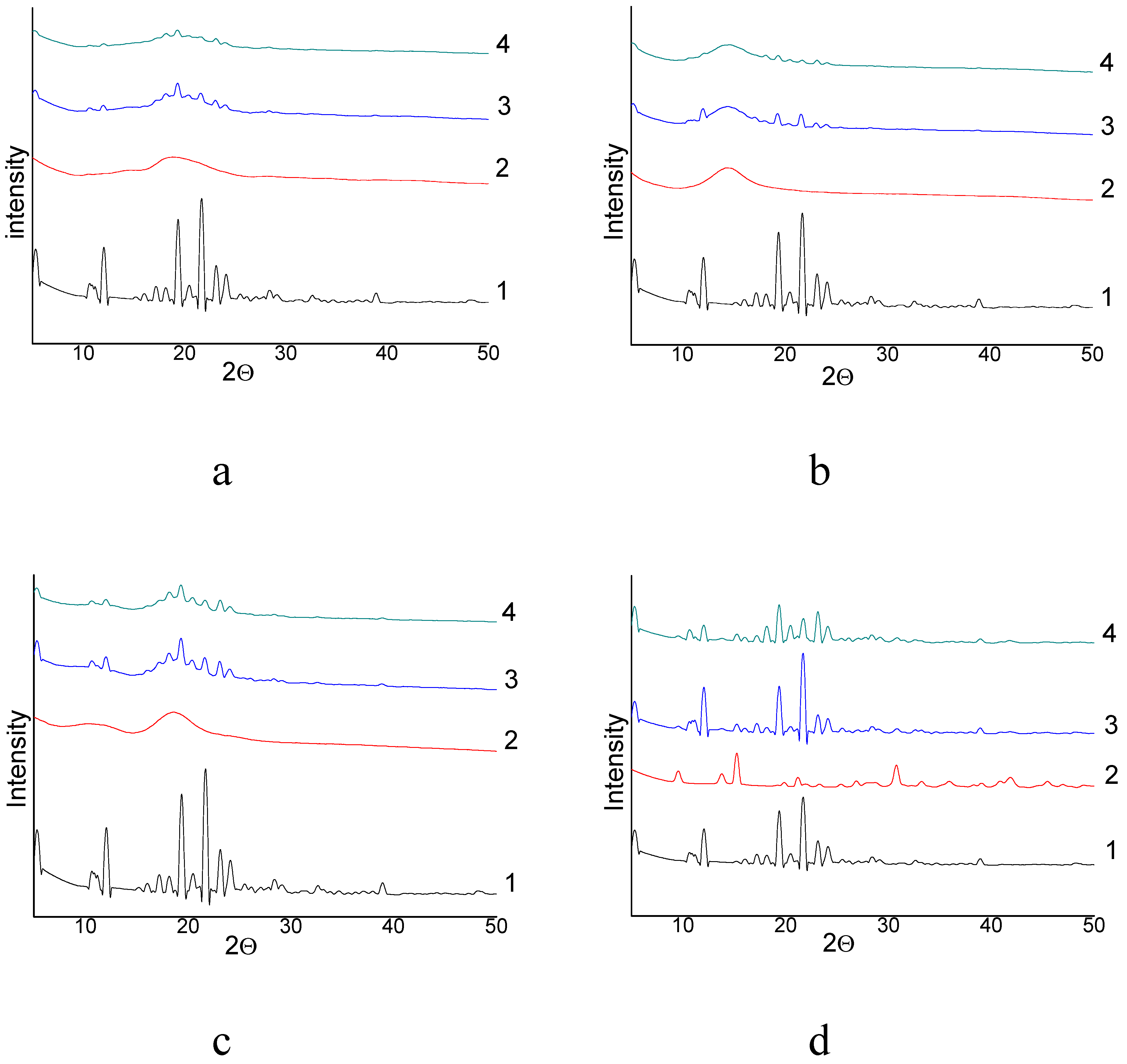

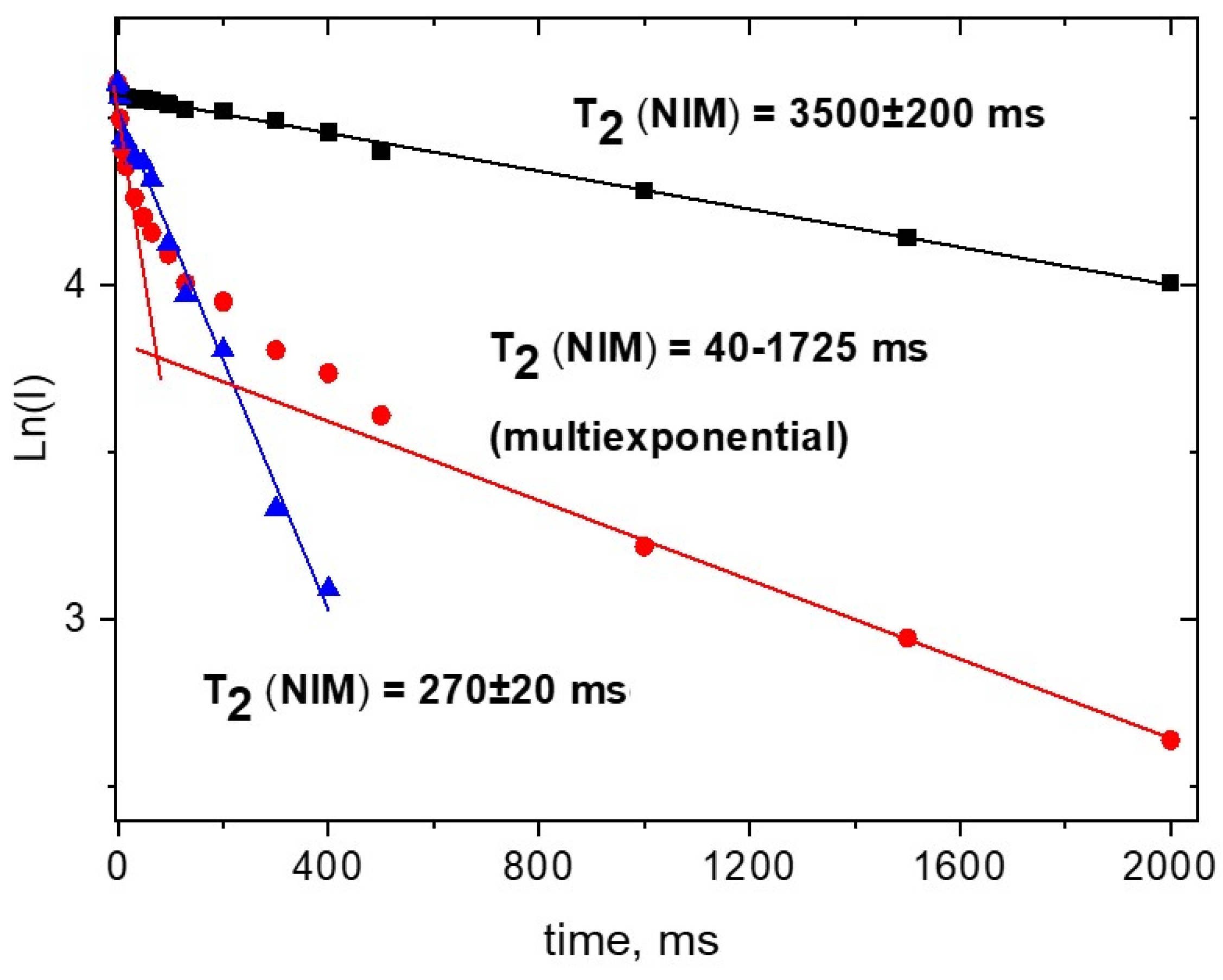
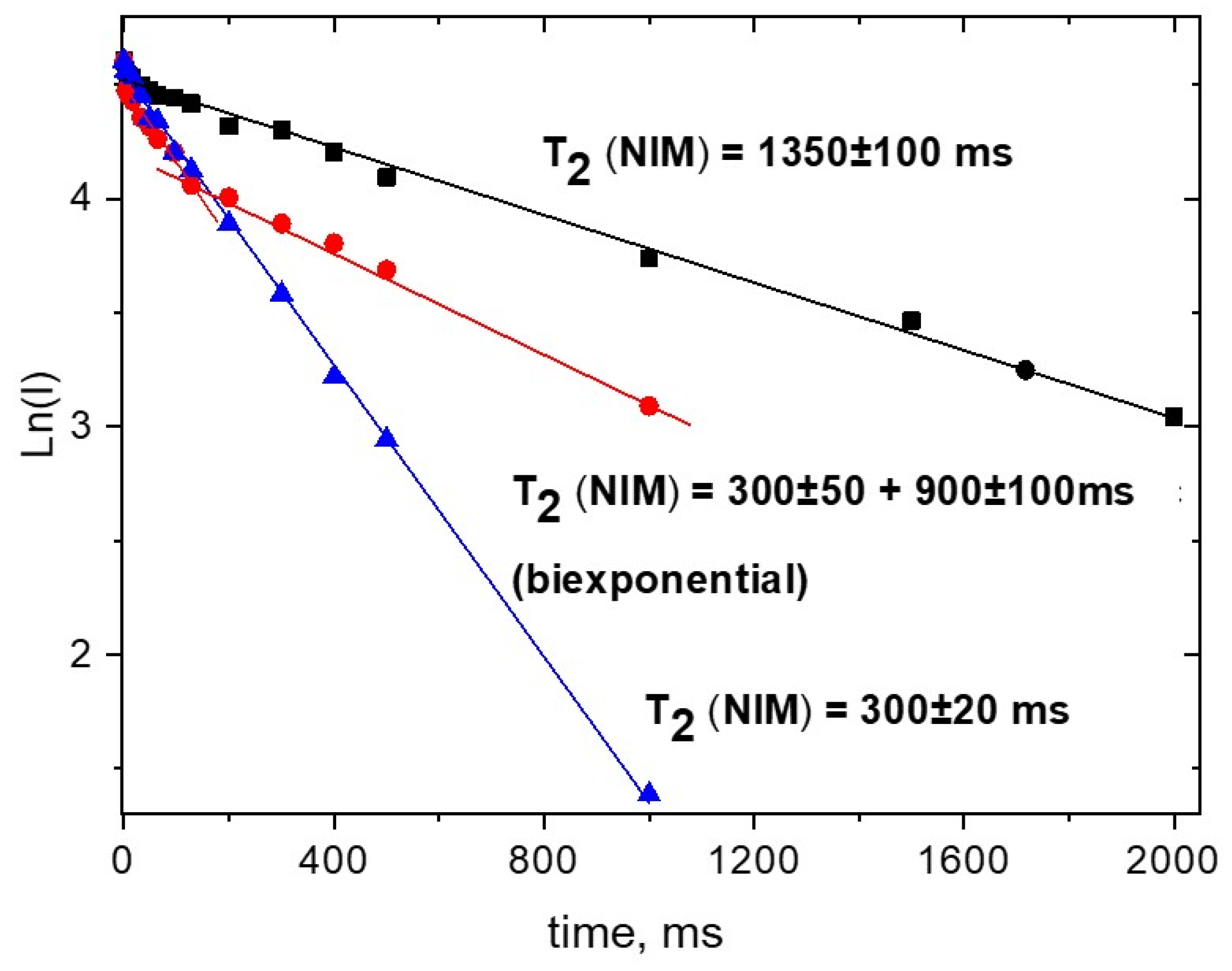
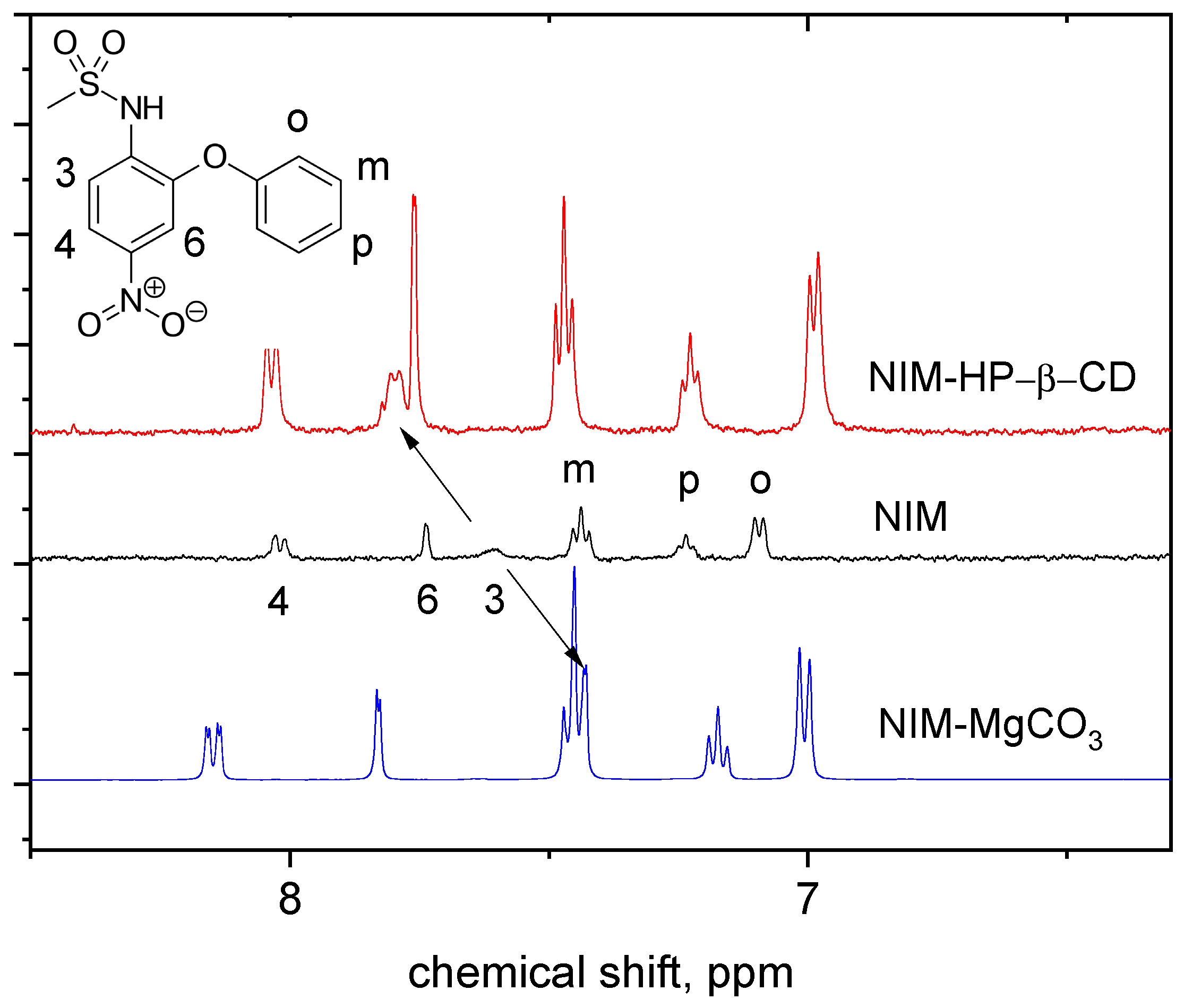
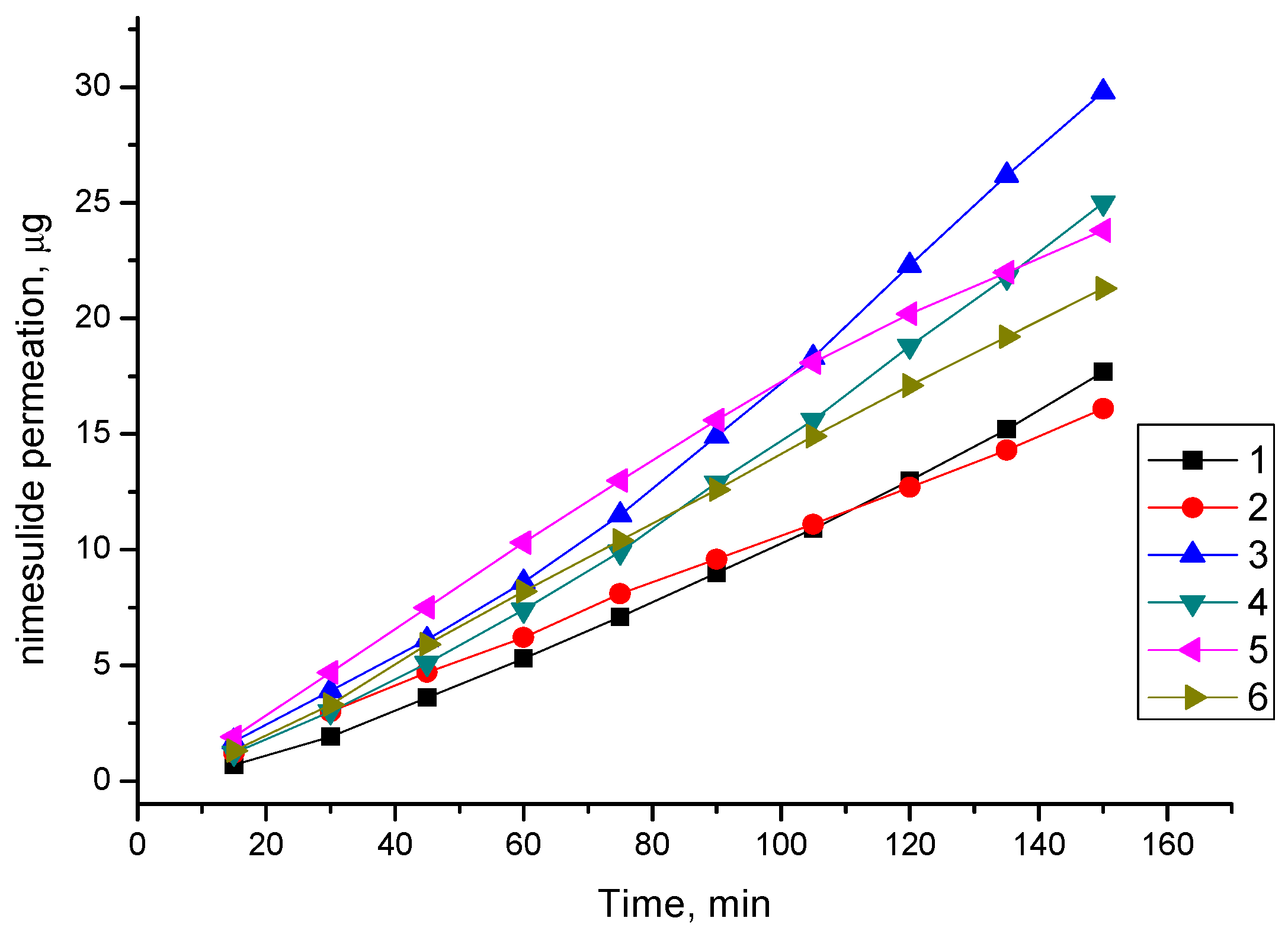
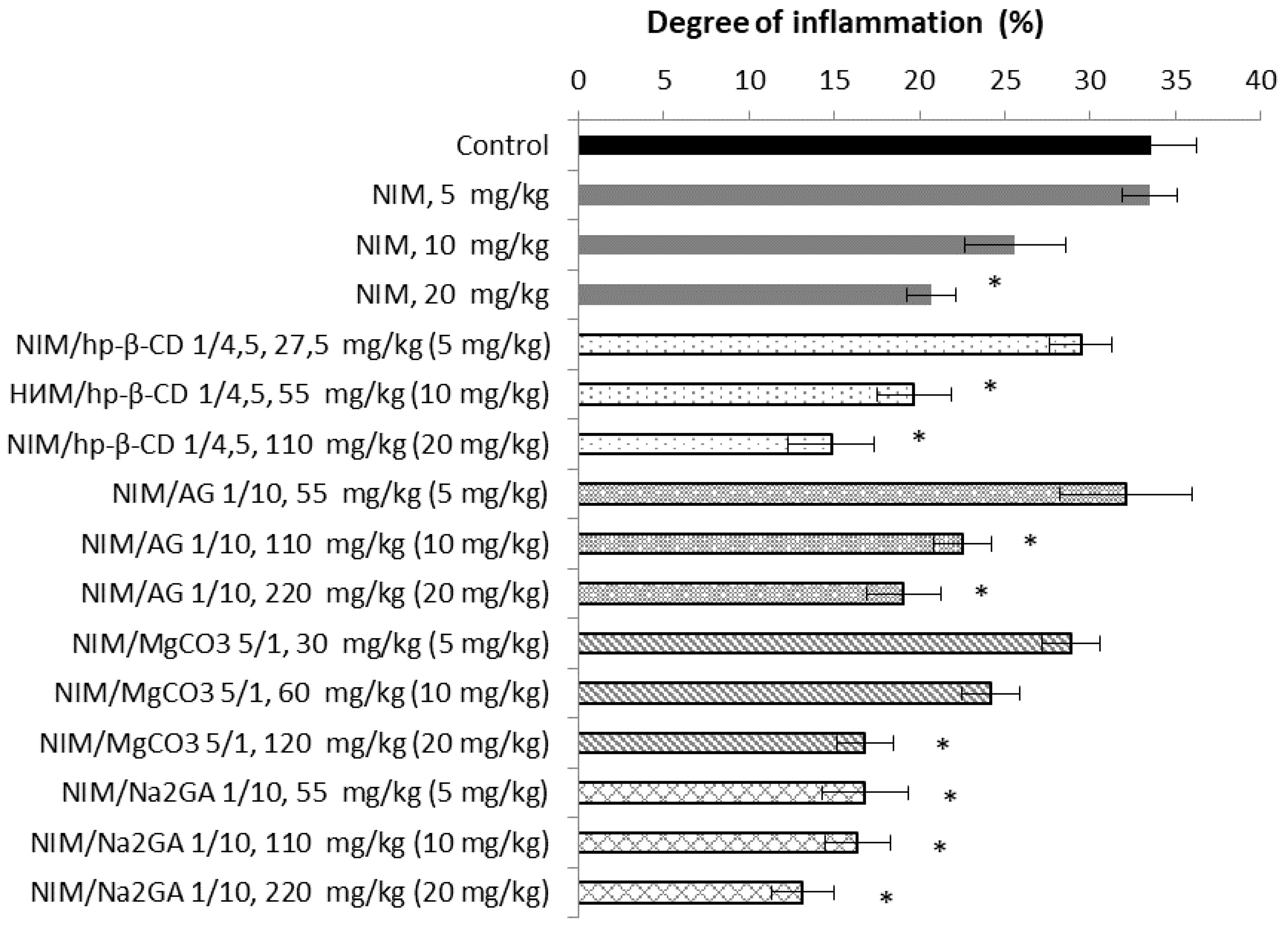
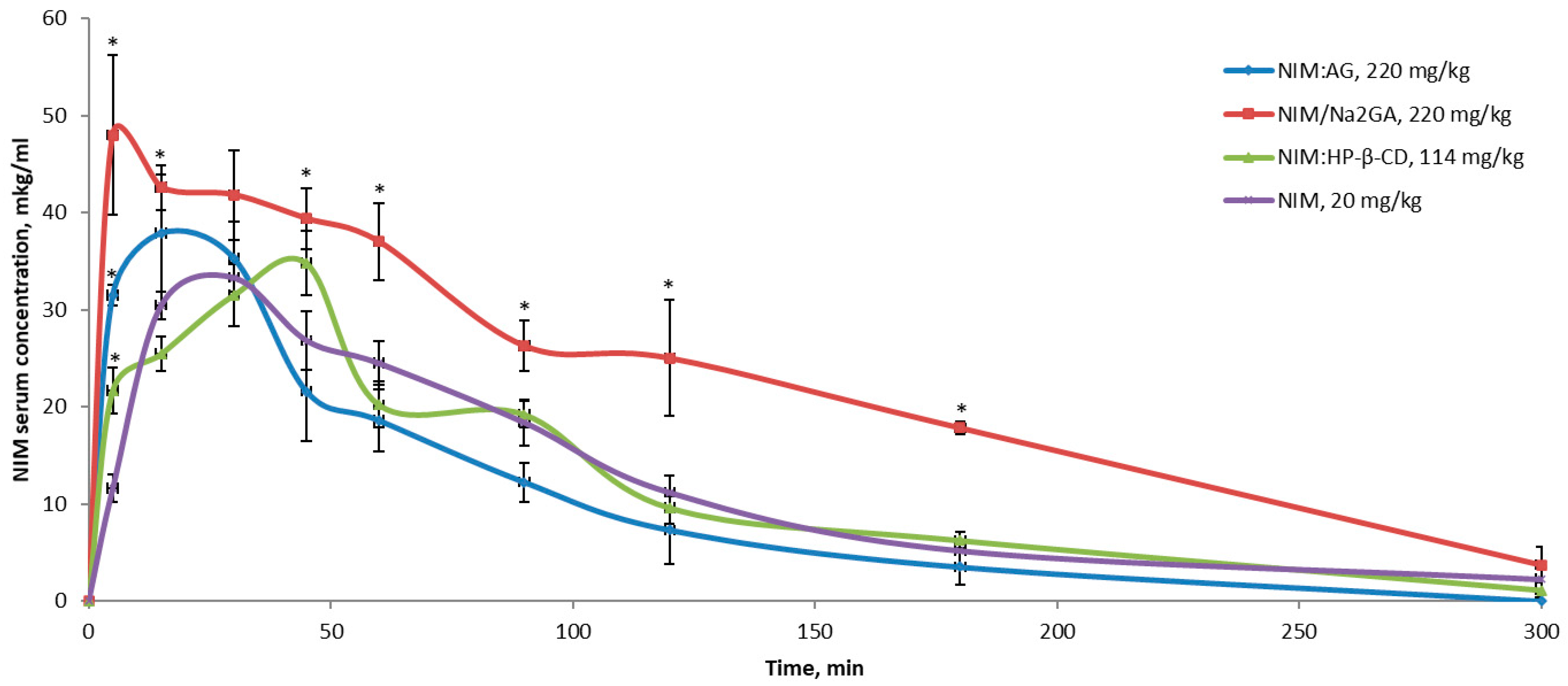
| Sample Content (Weights or Mole to Mole Ratios) and Time of Mechanical Treatment in Hours | Concentration of NIM in Water Solution, g/L | Increasing of Solubility, Times | pH of Solution |
|---|---|---|---|
| Nimesulid API | 0.019 | - | 6.4 |
| Nimesulide/AG, SD, 1/10, mass ratio, 4 h | 0.049 | 2.6 | 6.7 |
| Nimesulide/AG, PM, 1/10, mass ratio | 0.19 | - | 6.7 |
| Nimesulide/MgCO3, SD, 5/1, mass ratio, 1h | 2.041 | 107 | 9.2 |
| Nimesulide/MgCO3, PM, 5/1, mass ratio | 1.24 | 65 | 9.3 |
| Nimesulide HP-β-CD, SD, 1/1 mol ratio, 8 h | 0.059 | 3.1 | 6.6 |
| Nimesulide HP-β-CD, PM, 1/1 mol ratio | 0.029 | 1.5 | 6.6 |
| Nimesulide HP-β-CD, SD, 1/2 mol ratio, 4 h | 0.065 | 3.4 | 6.7 |
| Nimesulide HP-β-CD, PM, 1/2 mol ratio | 0.045 | 2.4 | 6.7 |
| Nimesulid/Na2GA, SD, 1/10, mass relation, 16 h | 0.181 | 9.5 | 5.8 |
| Nimesulid/Na2GA, PM, 1/10, mass relation | 0.029 | 1.5 | 5.8 |
| NIM:AG | NIM:Na2GA | NIM:HP-β-CD | NIM | |
|---|---|---|---|---|
| T1/2, min | 99.94 ± 43.03 | 83.45 ± 17.99 | 74.59 ± 12.45 | 89.09 ± 20.81 |
| Tmax, min | 30.00± 10.66 | 32.50 ± 7.37 | 36.00 ± 3.67 | 34.29 ± 6.31 |
| Cmax, mkg/mL | 38.50 ± 2.50 | 49.39 ± 2.20 * | 37.16 ± 3.41 | 38.43 ± 3.25 |
| AUC 0-inf_obs, mkg/mL*min | 4033.30 ± 597.85 | 7534.44 ± 576.98 * | 3898.39 ± 201.28 | 3978.88 ± 242.62 |
Publisher’s Note: MDPI stays neutral with regard to jurisdictional claims in published maps and institutional affiliations. |
© 2021 by the authors. Licensee MDPI, Basel, Switzerland. This article is an open access article distributed under the terms and conditions of the Creative Commons Attribution (CC BY) license (http://creativecommons.org/licenses/by/4.0/).
Share and Cite
Wei, W.; Evseenko, V.I.; Khvostov, M.V.; Borisov, S.A.; Tolstikova, T.G.; Polyakov, N.E.; Dushkin, A.V.; Xu, W.; Min, L.; Su, W. Solubility, Permeability, Anti-Inflammatory Action and In Vivo Pharmacokinetic Properties of Several Mechanochemically Obtained Pharmaceutical Solid Dispersions of Nimesulide. Molecules 2021, 26, 1513. https://doi.org/10.3390/molecules26061513
Wei W, Evseenko VI, Khvostov MV, Borisov SA, Tolstikova TG, Polyakov NE, Dushkin AV, Xu W, Min L, Su W. Solubility, Permeability, Anti-Inflammatory Action and In Vivo Pharmacokinetic Properties of Several Mechanochemically Obtained Pharmaceutical Solid Dispersions of Nimesulide. Molecules. 2021; 26(6):1513. https://doi.org/10.3390/molecules26061513
Chicago/Turabian StyleWei, Wei, Veronica I. Evseenko, Mikhail V. Khvostov, Sergey A. Borisov, Tatyana G. Tolstikova, Nikolay E. Polyakov, Aleksandr V. Dushkin, Wenhao Xu, Lu Min, and Weike Su. 2021. "Solubility, Permeability, Anti-Inflammatory Action and In Vivo Pharmacokinetic Properties of Several Mechanochemically Obtained Pharmaceutical Solid Dispersions of Nimesulide" Molecules 26, no. 6: 1513. https://doi.org/10.3390/molecules26061513
APA StyleWei, W., Evseenko, V. I., Khvostov, M. V., Borisov, S. A., Tolstikova, T. G., Polyakov, N. E., Dushkin, A. V., Xu, W., Min, L., & Su, W. (2021). Solubility, Permeability, Anti-Inflammatory Action and In Vivo Pharmacokinetic Properties of Several Mechanochemically Obtained Pharmaceutical Solid Dispersions of Nimesulide. Molecules, 26(6), 1513. https://doi.org/10.3390/molecules26061513









